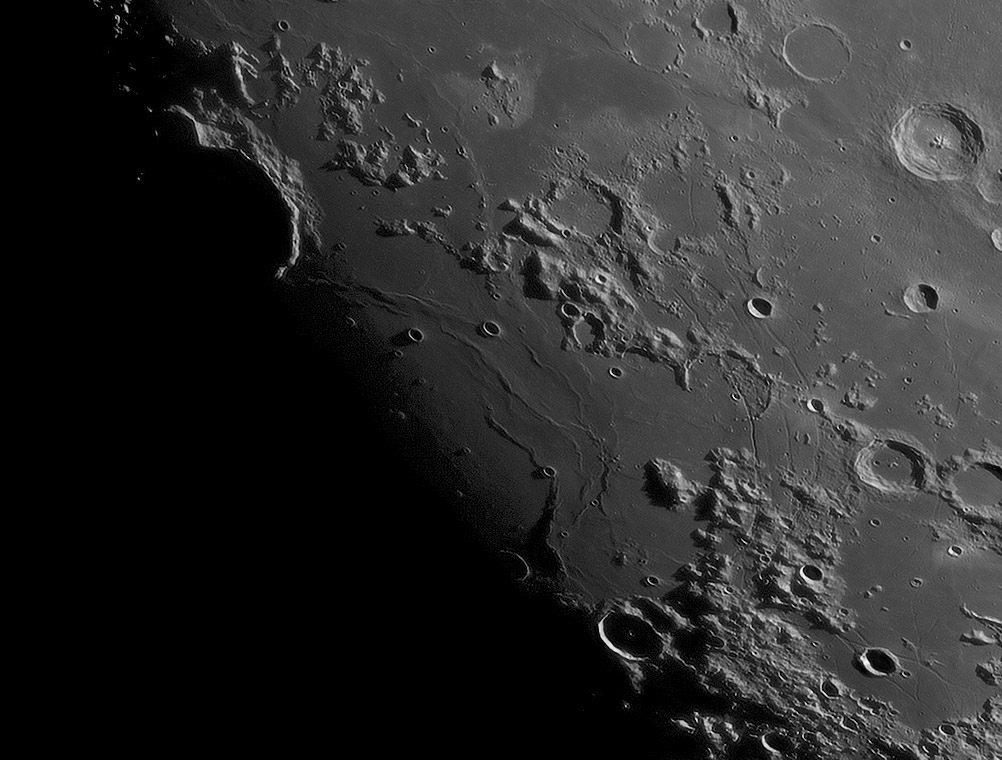Difference between revisions of "May 9, 2010"
| Line 3: | Line 3: | ||
<!-- ws:start:WikiTextHeadingRule:1:<h1> --> | <!-- ws:start:WikiTextHeadingRule:1:<h1> --> | ||
<!-- ws:start:WikiTextLocalImageRule:16:<img src="/file/view/LPOD-May9-10.jpg/140498737/LPOD-May9-10.jpg" alt="" title="" /> -->[[File:LPOD-May9-10.jpg|LPOD-May9-10.jpg]]<!-- ws:end:WikiTextLocalImageRule:16 --><br /> | <!-- ws:start:WikiTextLocalImageRule:16:<img src="/file/view/LPOD-May9-10.jpg/140498737/LPOD-May9-10.jpg" alt="" title="" /> -->[[File:LPOD-May9-10.jpg|LPOD-May9-10.jpg]]<!-- ws:end:WikiTextLocalImageRule:16 --><br /> | ||
| − | <em>image by [mailto:astronominsk@mail.ru | + | <em>image by [mailto:astronominsk@mail.ru Yuri Goryachko, Mikhail Abgarian, Konstantin Morozov], Minsk, Belarus</em><br /> |
<br /> | <br /> | ||
| − | With all the recent emphasis on data from lunar orbiters it might seem that little interesting can be seen from Earth. But this excerpt from a large [http://objectstyle.org/astronominsk/Moon/Moon2010/Moon_20100424_en.htm | + | With all the recent emphasis on data from lunar orbiters it might seem that little interesting can be seen from Earth. But this excerpt from a large [http://objectstyle.org/astronominsk/Moon/Moon2010/Moon_20100424_en.htm mosaic] by Yuri and the Astronominsk team dramatically demonstrates the utility and beauty of telescopic imaging. Here along the eastern shore of Mare Humorum are three sets of concentric curves that document the basin's dynamical story. Oldest is one of the best preserved sections of the Humorum Basin rim near bottom right. Although most of the mountainous edge is straight (the [http://the-moon.wikispaces.com/Rupes+Kelvin Kelvin Scarp]), the feeling of curvature is reinforced by the structural elements near it. The three famous [http://the-moon.wikispaces.com/Rimae+Hippalus Hippalus Rilles] mark where the edge of the crust bent and fractured. Why did this happen? Because the mass of the Humorum lavas to the left caused the center of the basin to sag, setting up strong bending stresses along the edges. The sinking also lowered the solidified lavas into a smaller volume, causing the mare materials to fracture and slide over previously adjacent parts, forming the wrinkle ridges. The near-terminator view shows a complexity to the ridges that can't be completely explained but does suggest how the ridges mark step-downs to the sunken center of the mare. None of this is new,, but it s beautifully shown.<br /> |
<br /> | <br /> | ||
| − | <em>[mailto:tychocrater@yahoo.com | + | <em>[mailto:tychocrater@yahoo.com Chuck Wood]</em><br /> |
<br /> | <br /> | ||
<strong>Technical Details</strong><br /> | <strong>Technical Details</strong><br /> | ||
| Line 14: | Line 14: | ||
<strong>Related Links</strong><br /> | <strong>Related Links</strong><br /> | ||
Rükl plate [http://the-moon.wikispaces.com/R%C3%BCkl+52 52]<br /> | Rükl plate [http://the-moon.wikispaces.com/R%C3%BCkl+52 52]<br /> | ||
| − | Astronominsk [http://objectstyle.org/astronominsk/index_en.htm | + | Astronominsk [http://objectstyle.org/astronominsk/index_en.htm website]<br /> |
<br /> | <br /> | ||
<hr /> | <hr /> | ||
| − | <div>You can support LPOD when you buy any book from Amazon thru [http://www.lpod.org/?page_id=591 | + | <div>You can support LPOD when you buy any book from Amazon thru [http://www.lpod.org/?page_id=591 LPOD!]<br /> |
</div> | </div> | ||
---- | ---- | ||
===COMMENTS?=== | ===COMMENTS?=== | ||
| − | + | Register, and click on the <b>Discussion</b> tab at the top of the page. | |
Revision as of 17:19, 11 January 2015
Curves

image by Yuri Goryachko, Mikhail Abgarian, Konstantin Morozov, Minsk, Belarus
With all the recent emphasis on data from lunar orbiters it might seem that little interesting can be seen from Earth. But this excerpt from a large mosaic by Yuri and the Astronominsk team dramatically demonstrates the utility and beauty of telescopic imaging. Here along the eastern shore of Mare Humorum are three sets of concentric curves that document the basin's dynamical story. Oldest is one of the best preserved sections of the Humorum Basin rim near bottom right. Although most of the mountainous edge is straight (the Kelvin Scarp), the feeling of curvature is reinforced by the structural elements near it. The three famous Hippalus Rilles mark where the edge of the crust bent and fractured. Why did this happen? Because the mass of the Humorum lavas to the left caused the center of the basin to sag, setting up strong bending stresses along the edges. The sinking also lowered the solidified lavas into a smaller volume, causing the mare materials to fracture and slide over previously adjacent parts, forming the wrinkle ridges. The near-terminator view shows a complexity to the ridges that can't be completely explained but does suggest how the ridges mark step-downs to the sunken center of the mare. None of this is new,, but it s beautifully shown.
Chuck Wood
Technical Details
April 24, 2010, 17:24-17:58UT, Maksutov-Cassegrain Santel D=230mm F=3000mm + Unibrain Fire-i 702 CCD b/w camera (IEEE-1394, 1388x1040) + Filter: Baader IR-pass 685nm+. Stacking in Avistack. Deconvolution in Astra
Related Links
Rükl plate 52
Astronominsk website
COMMENTS?
Register, and click on the Discussion tab at the top of the page.



